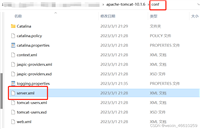最近打算还是了解点java吧,搞点小demo。
想了解的知识点:
- 数据请求的堆栈,因为遇到过数据库锁表需要定位。(今天做点记录,但有点不完美)
- 想得到数据库连接没释放的那个线程堆栈。
- 找个access访问记录的排序工具类。
线程池信息获取
- 线程池信息获取或者告警可以用 dynamic-tp
- 获取tomcat的线程信息可以用下面的代码
//获取webserver线程池
threadpoolexecutor executor = (threadpoolexecutor) ((tomcatwebserver) applicationcontext.getwebserver())
.gettomcat()
.getconnector()
.getprotocolhandler()
.getexecutor();
map<string, string> returnmap = new linkedhashmap<string, string>();
returnmap.put("核心线程数", string.valueof(executor.getcorepoolsize()));
returnmap.put("最大线程数", string.valueof(executor.getmaximumpoolsize()));
returnmap.put("活跃线程数", string.valueof(executor.getactivecount()));
returnmap.put("池中当前线程数", string.valueof(executor.getpoolsize()));
returnmap.put("历史最大线程数", string.valueof(executor.getlargestpoolsize()));
returnmap.put("线程允许空闲时间/s", string.valueof(executor.getkeepalivetime(timeunit.seconds)));
returnmap.put("核心线程数是否允许被回收", string.valueof(executor.allowscorethreadtimeout()));
returnmap.put("提交任务总数", string.valueof(executor.getsubmittedcount()));
returnmap.put("历史执行任务的总数(近似值)", string.valueof(executor.gettaskcount()));
returnmap.put("历史完成任务的总数(近似值)", string.valueof(executor.getcompletedtaskcount()));
returnmap.put("工作队列任务数量", string.valueof(executor.getqueue().size()));
returnmap.put("拒绝策略", executor.getrejectedexecutionhandler().getclass().getsimplename());
system.out.println(returnmap);
获取tomcat的线程堆栈信息
首先需要了解下线程的状态:
1.new(创建)创建态:当一个已经被创建的线程处于未被启动时,即:还没有调用start方法时,就处于这个状态。
2.runnable(运行时)运行态:当线程已被占用,在java虚拟机中正常执行时,就处于此状态。
3.blocked(排队时)阻塞态:当一个线程试图获取一个对象锁,而该对象锁被其他的线程持有,则该线程进入blocked状态。当该线程持有锁时,该线程将自动变成runnable状态。
4.waiting(休眠)休眠态:一个线程在等待另一个线程执行一个(唤醒)动作时,该线程进入waiting状态。进入这个状态后是不能自动唤醒的,必须等待另一个线程调用notify或者notifyall方法才能够唤醒。
5.timed_waiting (指定休眠时间)指定时间休眠态:基本同waiting状态,多了个超时参数,调用对应方法时线程将进入timed_waiting状态,这一状态将一直保持到超时期满或者接收到唤醒通知,带有超时参数的常用方法有thread.sleep、锁对象.wait() 。
6.terminated (结束)结束态:从runnable状态正常退出而死亡,或者因为没有捕获的异常终止了runnable状态而死亡。
系统启动的线程有哪些
count:18 方法2:线程池的线程:thread[catalina-utility-1,1,main] 方法2:线程池的线程:thread[catalina-utility-2,1,main] 方法2:线程池的线程:thread[container-0,5,main] 方法2:线程池的线程:thread[file watcher,5,main] 方法2:线程池的线程:thread[live reload server,5,main] -----------------名字包含了http 默认初始10个线程 -----------------acceptor线程主要用于监听套接字,将已连接套接字转给poller线程。 -----------------poller线程主要用于以较少的资源轮询已连接套接字以保持连接,当数据可用时转给工作线程。 方法2:线程池的线程:thread[http-nio-0.0.0.0-8089-exec-1,5,main] 方法2:线程池的线程:thread[http-nio-0.0.0.0-8089-exec-2,5,main] 方法2:线程池的线程:thread[http-nio-0.0.0.0-8089-exec-3,5,main] 方法2:线程池的线程:thread[http-nio-0.0.0.0-8089-exec-4,5,main] 方法2:线程池的线程:thread[http-nio-0.0.0.0-8089-exec-5,5,main] 方法2:线程池的线程:thread[http-nio-0.0.0.0-8089-exec-6,5,main] 方法2:线程池的线程:thread[http-nio-0.0.0.0-8089-exec-7,5,main] 方法2:线程池的线程:thread[http-nio-0.0.0.0-8089-exec-8,5,main] 方法2:线程池的线程:thread[http-nio-0.0.0.0-8089-exec-9,5,main] 方法2:线程池的线程:thread[http-nio-0.0.0.0-8089-exec-10,5,main] 方法2:线程池的线程:thread[http-nio-0.0.0.0-8089-poller,5,main] 方法2:线程池的线程:thread[http-nio-0.0.0.0-8089-acceptor,5,main] -------------------- 方法2:线程池的线程:thread[destroyjavavm,5,main]
代码
thread mainthread = thread.currentthread();
threadgroup mainthreadthreadgroup = mainthread.getthreadgroup();
//获取线程组中的线程。
int count = mainthreadthreadgroup.activecount();
system.out.println("count:"+count);
thread[] threads = new thread[count];
//enumerate 枚举,recurse 递归
mainthreadthreadgroup.enumerate(threads, true);
stream.of(threads).filter(thread::isalive).foreach(thread -> system.out.println("方法2:线程池的线程:" + thread ));
http的线程根据上面的信息
waiting状态的排除,名字做点过滤,去掉当前线程,因为从上面得到的线程池不知道怎么得到线程,这里拿到所有做过滤。
map<thread, stacktraceelement[]> allthread = thread.getallstacktraces();
for (thread t : allthread.keyset()) {
/**
* 一个线程可以在给定时间点处于一个状态。 这些状态是不反映任何操作系统线程状态的虚拟机状态。
*
* 线程状态。 线程可以处于以下状态之一:
* new 尚未启动的线程处于此状态。
* runnable 在java虚拟机中执行的线程处于此状态。
* blocked 被阻塞等待监视器锁定的线程处于此状态。
* waiting 正在等待另一个线程执行特定动作的线程处于此状态。
* timed_waiting 正在等待另一个线程执行动作达到指定等待时间的线程处于此状态。
* terminated 已退出的线程处于此状态。
* */
stringbuilder sb=new stringbuilder();
if(!thread.state.waiting.equals(t.getstate()) &&
t.getname().indexof("http")>-1 &&
!thread.currentthread().equals(t)) {
system.out.println(t.getname()+":"+t.getstate());
sb.setlength(0);
for (stacktraceelement ele : t.getstacktrace()) {
sb.append(ele.getclassname()).append(".").append(ele.getmethodname()).append(".").append(ele.getfilename()).append("$").append(ele.getlinenumber()).append("\n");
}
system.out.println(sb.tostring());
}
}
测试
@requestmapping(value = "/hello")
public string testhello(model model) throws interruptedexception {
thread.sleep(5000);
model.addattribute("currenttime", new date());
return "hello";
}
@requestmapping(value = "/hello2")
public string testhello2(model model) throws interruptedexception {
for(int i=0;i<integer.max_value;i++){
for(int j=0;j<integer.max_value;j++){}
}
model.addattribute("currenttime", new date());
return "hello";
}
以上就是tomcat获取执行的线程池信息和线程堆栈的方法详解的详细内容,更多关于tomcat线程池信息和线程堆栈的资料请关注代码网其它相关文章!




发表评论